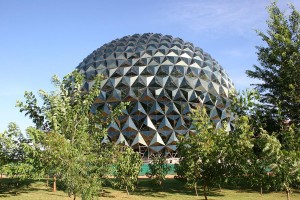INFOSYS walking the talk on "green" goals


DELHI -- INFOSYS, India’s mega IT services company, wants 100 percent of its energy from renewable sources by 2017. SmartPlanet talked to Rohan Parikh, head of Green Intiatives and Infrastructure, about how this goal will be achieved in the next five years.
Last year, Newsweek ranked INFOSYS as the eighth greenest global company in the world. Being implemented are diverse steps from constructing green buildings and rain water harvesting to using energy efficient lights and programs to shut down computers when not in use. Presently, 20 percent of the Bangalore- based company's energy needs are generated by renewables.
Parikh said that INFOSYS was “on track” to achieve its 2017 goal through two routes. First, reducing the per capita emissions of the company, which employs more than 100,000 people in scores of development centres. And then, generating energy from offsite and onsite renewable sources.
While the company has some solar energy and wind turbine projects within its campuses, the bulk of green electricity comes from offsite project developers. Generating solar or wind energy on site, which requires heavy investments and land, does not make good business sense to the company yet. Parikh noted that offsite contracts will continue to increase as the company expands and consumption grows.
On the construction front, Parikh said that the company’s new buildings are “conforming to the highest standard of green buildings in the world.” A core team of specialists are also working to improve their old ones. It is estimated that each INFOSYS employee consumes about 180 to 200 units of energy every month. The goal is to reduce this to 70 units. This includes saving energy in air conditioning, lighting and computers.
To keep offices cool, Parikh said that their engineers thought about how people kept cool before air conditioning or why are caves cool (due to the water in the surface). He talked about a “radiant cooling” system in the Hyderabad office that works off human beings radiating heat. The human body stays at about 35 degree Celsius but is comfortable at 24. Under the cooling system, the heat radiated by the body is absorbed by cold water in water pipes running through under the floor and above on the ceiling in offices. Compared to regular air conditioned building, the one with the radiant cooling reduces energy consumption by 32%.
To save on lighting, buildings have been designed to be sufficiently lit by the sunlight while eliminating the glare. The high performance glass keeps out harmful ultra violet rays. This eliminates the need to use electricity during the day. “We handle daylight very carefully,” said Parikh. The windows in these buildings use the “light shelf” design--reflectors that allow the light to bounce and go deeper into the spaces of rooms.
Parikh, however, noted that the company produces only a limited amount of green energy on its own. Solar energy, generated on campus rooftops, are being used to heat water in hotels and kitchens in their development centres.
On conserving water, Parikh said they are trying to sensitize all their employees about the need for saving water because India will face a water crisis before an energy one. The company’s aspirational goal is to survive only on rain water. For this purpose, they are creating catchments to sequester more and more rain water. This also reduces the dependence of the municipal sewer system. The campus in Mysore has reduced more than 30 percent of its water consumption.
Water efficient fixtures, a novelty in India, have found its way into Infosys. The company uses taps that expel four litres of water a minute instead of the regular 10 litres. Showers in their hotels expel 6 litres of water instead of 20. For housekeeping, dry mops are used for cleaning instead of wet ones. “We have a zero discharge policy,” said Parikh. Water is recycled multiple times to used in flushing, air-conditioning and landscaping.
Another source of electricity being explored by INFOSYS is the waste gas that is produced when, for instance, manufacturing steel or cement. This mechanism, called waste gas recovery, is already pretty popular in India. In a lot of manufacturing plants, however, this waste gas still goes unutilized through the chimney. If this idea was implemented through a contract, it would also be necessary to have some checks and balances since the primary source of energy (in producing cement or iron ore) is coal. A third party audit would ensure that the project developer is only supplying electricity through the waste gas.
Photos-- INFOSYS
This post was originally published on Smartplanet.com